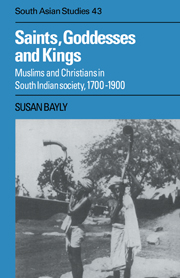Book contents
- Frontmatter
- Contents
- List of plates
- List of maps
- Preface
- Note on transliteration
- List of abbreviations
- Introduction
- Part I
- Part II
- 7 South Indian Christians in the pre-colonial period
- 8 The collapse of Syrian Christian ‘integration’
- 9 The Christian Paravas of southern Tamilnad
- 10 Christian saints and gurus in the poligar country
- 11 Christianity and colonial rule in the Tamil hinterland
- 12 Conclusion
- Select glossary
- Bibliography
- Index
- CAMBRIDGE SOUTH ASIAN STUDIES
- Plate section
10 - Christian saints and gurus in the poligar country
from Part II
Published online by Cambridge University Press: 04 December 2009
- Frontmatter
- Contents
- List of plates
- List of maps
- Preface
- Note on transliteration
- List of abbreviations
- Introduction
- Part I
- Part II
- 7 South Indian Christians in the pre-colonial period
- 8 The collapse of Syrian Christian ‘integration’
- 9 The Christian Paravas of southern Tamilnad
- 10 Christian saints and gurus in the poligar country
- 11 Christianity and colonial rule in the Tamil hinterland
- 12 Conclusion
- Select glossary
- Bibliography
- Index
- CAMBRIDGE SOUTH ASIAN STUDIES
- Plate section
Summary
New hinterland cult traditions
Thus far Christianity has appeared here as a religion of coastal people, of élite Malayali warrior-landholders, and of Tamil-speaking fishermen and seaborne traders. Two sets of questions must be asked at this point. First, how did Christian worship spread into the Tamil hinterland, and why did so much of south India's inland population, most notably the Shanar toddy tappers, Paraiyan labourers and other low-ranking agricultural groups of the Tamil plains country, come to be hailed in missionary circles as one of the largest and most successful ‘mission fields’ in the subcontinent?
Secondly, what was the nature of the Christian religious tradition which developed in the Tamil hinterland? The Paravas were a fairly coherent and stable group with tendencies to hierarchy which arose partly from the intermittent church discipline which was imposed on them, but more importantly from trends within their pre-existing Tamil religious and social background. The combination of tightknit organisation and hierarchy which characterised the Paravas was also typical of many other specialist occupational groups in the sub-continent, particularly coastal groups and inhabitants of the rich rice-growing valley regions. In the drier and more volatile Tamil hinterland, too, Christian and Hindu worship came to share many of the same forms, rites and concepts. Once again the dynamics of this Christian worship came to reflect the society around it, even when more formal Christian values were articulated by the various convert groups. In this case the Christians of the hinterland generated a form of volatile bhakti or devotional worship of a type which was characteristic of their more numerous Hindu neighbours.
- Type
- Chapter
- Information
- Saints, Goddesses and KingsMuslims and Christians in South Indian Society, 1700–1900, pp. 379 - 419Publisher: Cambridge University PressPrint publication year: 1990



